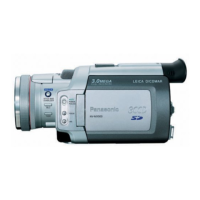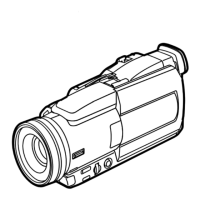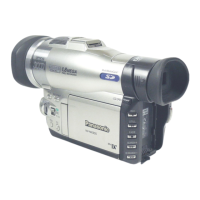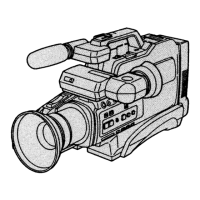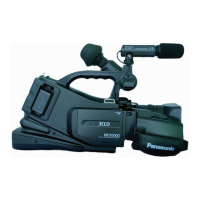Do you have a question about the Panasonic NV-MX500 and is the answer not in the manual?
Covers ventilation, moisture exposure, and electrical safety for the equipment.
Details plug wiring, fuse replacement, and safety measures for the AC mains lead.
Covers service recommendations and copyright law adherence for recordings.
Lists all items that are supplied with the Movie Camera.
Lists optional items that can be purchased for the Movie Camera.
Details buttons, switches, and indicators on the camera body for camera mode.
Details buttons for VCR mode playback and card operations.
Instructions for inserting the battery and operating the remote controller.
How to select operating modes for simultaneous camera and remote control.
Connecting the AC adaptor and charging the camera battery.
Details charging times and maximum continuous recording times for various batteries.
Instructions for attaching the lens cap and grip belt for protection and handling.
Adjusting the grip belt for hand fit and attaching the shoulder strap.
How to insert a cassette and prevent accidental erasure.
Steps to turn on the camera and select operational modes.
Adjusting and using the camera's viewfinder and LCD monitor.
How to access and navigate the camera's menu system for settings.
Basic camera settings like AE, zoom, and recording mode.
Features like Zebra pattern, mic adjustments, and picture settings.
Special video effects, their settings, and application.
Settings for memory cards and multi-picture features.
Steps to start, pause, and stop recording video.
Explains the function of the tally lamp during recording.
How to record yourself using the LCD monitor.
Capturing still pictures with sound.
High-resolution still picture capture.
Using zoom and its effect on the microphone's directional angle.
Extending zoom range beyond optical limits for close-up shots.
Correcting camera shake for clearer images.
Gradually fading images and sounds in or out at scene start/end.
Adjusting for challenging lighting conditions and low-light recording.
Minimizing wind noise when recording outdoors.
Applying cinematic or widescreen aspect ratio effects.
Selecting automatic exposure settings for various scenes.
Correcting color balance based on the light source.
Adjusting exposure time manually for fast-moving subjects.
Adjusting lens aperture manually for brightness control.
How the white balance sensor works and its limitations.
Manually focusing on subjects when auto-focus is inadequate.
Locking exposure settings to maintain consistent brightness.
Adjusting picture brightness reference and microphone sensitivity.
Fine-tuning image sharpness, color, and using color bars for calibration.
Using the built-in flash for better illumination in dark scenes.
Introduction to the camera's digital effects for scene enhancement.
More special video effects including Sepia, Black & White, and Mirror.
Creating transitions between scenes using Wipe and Mix effects.
Displaying a smaller image within the main screen.
Capturing sequences of still images using Strobe or Manual modes.
Managing and deleting captured multi-picture sequences.
Playing recorded tapes and finding specific scenes using search functions.
Playing back recorded video at a slow speed.
Frame-by-frame playback and searching using index signals.
Locating the end of recorded content on the tape.
Searching for scenes marked with index signals.
Advanced tape searching functionality.
Enlarging parts of the playback image.
Applying special effects during tape playback.
Connecting the camera to a television for playback.
Searching within multi-picture displays on the TV.
Adding music or narration to recorded tapes.
Dubbing video content from the camera to a VHS cassette.
Connecting external video devices for recording.
Performing digital dubbing using a DV cable.
Steps for handling memory cards, including insertion and removal.
Capturing still images on a memory card.
Adjusting for low-light recording on cards.
Copying tape content to a memory card.
Choosing resolution for still images recorded on the card.
Capturing video for email or PC playback.
Accessing recorded data (pictures, MPEG4, voice) on the memory card.
Specific playback options for video and audio files.
Transferring one image at a time from card to tape.
Batch transfer of all pictures from card to tape.
Finding and selecting specific files on the memory card.
Creating and viewing a slideshow of still pictures from the card.
Customizing slideshow playback order, time, and selection.
Checking the pictures selected for the slideshow.
Removing specific images from the memory card.
Adding text overlays to images for titles.
Locking files on the card to prevent accidental deletion.
Erasing data and preparing memory cards for reuse.
Setting print order information for photo printing.
Configuring print settings and verifying DPOF data.
Using a kit to import still pictures into your PC.
Using a USB kit to transfer still images to your PC.
Connecting the camera to your PC for video conferencing.
How files are organized on SD and Multimedia Cards when accessed via PC.
Important considerations for PC use of card data.
Explains various symbols and indicators on the camera screen.
Status indicators for battery power and remaining tape time.
Explains warning lights, error messages, and basic troubleshooting steps.
Registering ownership information to identify the camera owner.
Cautions for use, power supply, cleaning, and environmental factors.
Battery charging times and recording duration details.
Inserting/removing cassettes and notes on frame recording.
Notes and limitations for still picture modes.
Precautions for backlight compensation, night view, cinema, and wide modes.
Restrictions on manual white balance and exposure adjustments.
Restrictions on using flash with digital effects and vice versa.
Specific usage notes for multi-picture modes and playback features.
Limitations for zoom and effects during playback.
Limitations and considerations when recording to memory cards.
Specific restrictions for MPEG4 and voice recording modes.
Compatibility and title usage issues with card data.
Care for the camera body, lens, and avoiding dust or chemicals.
Safety measures for cleaning and using the AC adaptor.
Issues with charging lamps and battery temperature effects.
What to do if condensation forms inside the camera.
How to clean the video heads using a cleaner cassette.
Battery care after use and precautions for storing the camera.
Battery life considerations and LCD screen performance details.
Using the viewfinder and attaching lens accessories.
A basic guide to troubleshooting common camera issues.
Camera won't turn on, battery issues, and recording errors.
Issues encountered during tape playback and card operations.
Definitions related to digital video systems and compatibility.
Explanations of auto-focus functionality and time code data.
How to use the memory stop feature for tape positioning.
Technical details of the digital video camera, including dimensions and power.
Technical details of the AC power adapter.
Number of still pictures recordable on an SD memory card by size and quality.
Recording duration for MPEG4 video and voice on an SD memory card.
Covers ventilation, moisture exposure, and electrical safety for the equipment.
Details plug wiring, fuse replacement, and safety measures for the AC mains lead.
Covers service recommendations and copyright law adherence for recordings.
Lists all items that are supplied with the Movie Camera.
Lists optional items that can be purchased for the Movie Camera.
Details buttons, switches, and indicators on the camera body for camera mode.
Details buttons for VCR mode playback and card operations.
Instructions for inserting the battery and operating the remote controller.
How to select operating modes for simultaneous camera and remote control.
Connecting the AC adaptor and charging the camera battery.
Details charging times and maximum continuous recording times for various batteries.
Instructions for attaching the lens cap and grip belt for protection and handling.
Adjusting the grip belt for hand fit and attaching the shoulder strap.
How to insert a cassette and prevent accidental erasure.
Steps to turn on the camera and select operational modes.
Adjusting and using the camera's viewfinder and LCD monitor.
How to access and navigate the camera's menu system for settings.
Basic camera settings like AE, zoom, and recording mode.
Features like Zebra pattern, mic adjustments, and picture settings.
Special video effects, their settings, and application.
Settings for memory cards and multi-picture features.
Steps to start, pause, and stop recording video.
Explains the function of the tally lamp during recording.
How to record yourself using the LCD monitor.
Capturing still pictures with sound.
High-resolution still picture capture.
Using zoom and its effect on the microphone's directional angle.
Extending zoom range beyond optical limits for close-up shots.
Correcting camera shake for clearer images.
Gradually fading images and sounds in or out at scene start/end.
Adjusting for challenging lighting conditions and low-light recording.
Minimizing wind noise when recording outdoors.
Applying cinematic or widescreen aspect ratio effects.
Selecting automatic exposure settings for various scenes.
Correcting color balance based on the light source.
Adjusting exposure time manually for fast-moving subjects.
Adjusting lens aperture manually for brightness control.
How the white balance sensor works and its limitations.
Manually focusing on subjects when auto-focus is inadequate.
Locking exposure settings to maintain consistent brightness.
Adjusting picture brightness reference and microphone sensitivity.
Fine-tuning image sharpness, color, and using color bars for calibration.
Using the built-in flash for better illumination in dark scenes.
Introduction to the camera's digital effects for scene enhancement.
More special video effects including Sepia, Black & White, and Mirror.
Creating transitions between scenes using Wipe and Mix effects.
Displaying a smaller image within the main screen.
Capturing sequences of still images using Strobe or Manual modes.
Managing and deleting captured multi-picture sequences.
Playing recorded tapes and finding specific scenes using search functions.
Playing back recorded video at a slow speed.
Frame-by-frame playback and searching using index signals.
Locating the end of recorded content on the tape.
Searching for scenes marked with index signals.
Advanced tape searching functionality.
Enlarging parts of the playback image.
Applying special effects during tape playback.
Connecting the camera to a television for playback.
Searching within multi-picture displays on the TV.
Adding music or narration to recorded tapes.
Dubbing video content from the camera to a VHS cassette.
Connecting external video devices for recording.
Performing digital dubbing using a DV cable.
Steps for handling memory cards, including insertion and removal.
Capturing still images on a memory card.
Adjusting for low-light recording on cards.
Copying tape content to a memory card.
Choosing resolution for still images recorded on the card.
Capturing video for email or PC playback.
Accessing recorded data (pictures, MPEG4, voice) on the memory card.
Specific playback options for video and audio files.
Transferring one image at a time from card to tape.
Batch transfer of all pictures from card to tape.
Finding and selecting specific files on the memory card.
Creating and viewing a slideshow of still pictures from the card.
Customizing slideshow playback order, time, and selection.
Checking the pictures selected for the slideshow.
Removing specific images from the memory card.
Adding text overlays to images for titles.
Locking files on the card to prevent accidental deletion.
Erasing data and preparing memory cards for reuse.
Setting print order information for photo printing.
Configuring print settings and verifying DPOF data.
Using a kit to import still pictures into your PC.
Using a USB kit to transfer still images to your PC.
Connecting the camera to your PC for video conferencing.
How files are organized on SD and Multimedia Cards when accessed via PC.
Important considerations for PC use of card data.
Explains various symbols and indicators on the camera screen.
Status indicators for battery power and remaining tape time.
Explains warning lights, error messages, and basic troubleshooting steps.
Registering ownership information to identify the camera owner.
Cautions for use, power supply, cleaning, and environmental factors.
Battery charging times and recording duration details.
Inserting/removing cassettes and notes on frame recording.
Notes and limitations for still picture modes.
Precautions for backlight compensation, night view, cinema, and wide modes.
Restrictions on manual white balance and exposure adjustments.
Restrictions on using flash with digital effects and vice versa.
Specific usage notes for multi-picture modes and playback features.
Limitations for zoom and effects during playback.
Limitations and considerations when recording to memory cards.
Specific restrictions for MPEG4 and voice recording modes.
Compatibility and title usage issues with card data.
Care for the camera body, lens, and avoiding dust or chemicals.
Safety measures for cleaning and using the AC adaptor.
Issues with charging lamps and battery temperature effects.
What to do if condensation forms inside the camera.
How to clean the video heads using a cleaner cassette.
Battery care after use and precautions for storing the camera.
Battery life considerations and LCD screen performance details.
Using the viewfinder and attaching lens accessories.
A basic guide to troubleshooting common camera issues.
Camera won't turn on, battery issues, and recording errors.
Issues encountered during tape playback and card operations.
Definitions related to digital video systems and compatibility.
Explanations of auto-focus functionality and time code data.
How to use the memory stop feature for tape positioning.
Technical details of the digital video camera, including dimensions and power.
Technical details of the AC power adapter.
Number of still pictures recordable on an SD memory card by size and quality.
Recording duration for MPEG4 video and voice on an SD memory card.
| Recording Media | MiniDV |
|---|---|
| Optical Zoom | 10x |
| Digital Zoom | 500x |
| LCD Screen Size | 3.5 inches |
| Image Sensor | 3CCD |
| Image Sensor Type | CCD |
| Lens | Leica Dicomar |
| Microphone | Stereo |
| Type | Digital |
| Video Resolution | 720 x 576 |
| Recording Format | DV |
| Effective Pixels | 0.8 Megapixels |
| LCD Screen | Color LCD |
| Viewfinder | Color |
